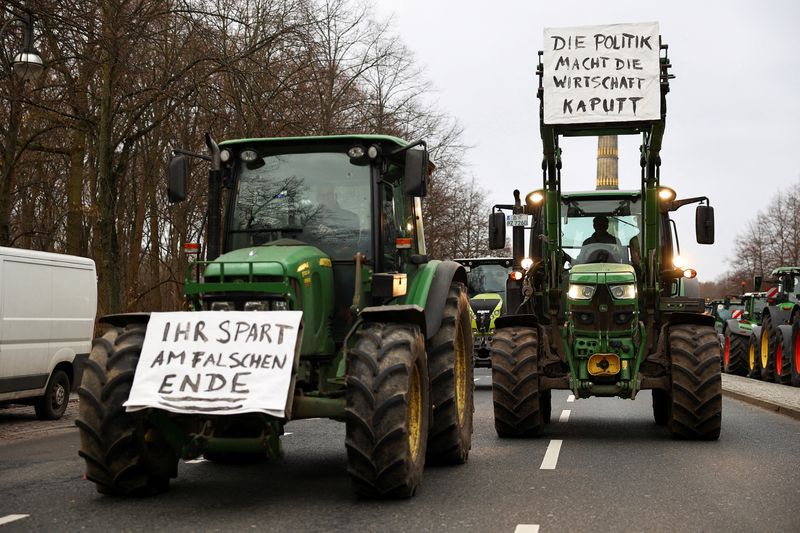Explainer-Why is Germany’s economy struggling in 2024?
2024.01.08 07:28
4/4

© Reuters. FILE PHOTO: German farmers in tractors take part in a protest against the cut of vehicle tax subsidies, as signs are displayed on the front of their tractors that read “You’re saving at the wrong end” and “Politics is breaking the economy”, in Berlin, Ger
2/4
By Maria Martinez
BERLIN (Reuters) – Germany’s ailing economy is experiencing a bumpy start to the year with farmers launching nationwide protests against government plans to cut diesel subsidies and train drivers planning several days of strikes over wage disputes.
The economy, Europe’s biggest, was the weakest among its large euro zone peers last year, as high energy costs, feeble global orders and record-high interest rates took their toll.
The government then suffered a huge blow in November when Germany’s top court threw out its 2024 budget plans, forcing divisive political wrangling over how to fill a 17 billion euro ($18.6 billion) funding gap.
Long-term structural problems surrounding Germany’s workforce and infrastructure also remain unresolved.
The International Monetary Fund predicts Germany will be the only G7 economy that shrank in 2023 and at 0.9%, growth is expected to remain well below the average of 1.4% for advanced economies in 2024.
Here are some of the challenges facing Germany’s economy in 2024:
PROTESTS
Chancellor Olaf Scholz’s coalition has watered down proposals in its hastily reworked budget to cut diesel subsidies. However, the president of the German Farmers’ Association said this did not go far enough and kept plans for nationwide rallies this week.
The Christmas truce declared by the GDL train drivers’ union also ended on Monday. GDL plans a strike that would last several days as a wage dispute with rail operator Deutsche Bahn continues.
Deutsche Bahn presented a new offer on Friday which it hopes will resolve the dispute, but it is also seeking an injunction to stop the industrial action. GDL is studying the new proposal.
BUDGET TURMOIL
Scholz’s three-party coalition announced an agreement on the key points of the draft budget for 2024 in December following weeks of negotiations after the Constitutional Court ruling threw the government’s finances into disarray.
As sought by Finance Minister Christian Lindner, an advocate of budgetary rigour, Germany will reinstate its cap on new net borrowing in 2024 and fill funding gaps worth a total 17 billion euros largely with cost savings.
This will drag further on already insipid growth. Three leading German economic institutes cut their 2024 economic growth forecasts saying the budget crisis was delaying the recovery.
Ifo now expects Germany to grow by 0.9% next year instead of 1.4%, while RWI cut its forecast to 0.8% from 1.1% and DIW dropped its prediction to 0.6% from 1.2%.
“Uncertainty is currently delaying the recovery, as it increases consumers’ propensity to save and reduces the willingness of companies and private households to invest,” said Ifo’s head of forecasts Timo Wollmershaeuser.
WEAKENED COALITION
The budget wrangling has raised tensions in the already loveless three-way coalition and polls show the big winners of the crisis are the opposition conservatives and far-right Alternative for Germany (AfD).
Increased tensions and the need to focus on finishing the 2024 budget agreement are delaying structural reforms promised by the government when it took office including cutting bureaucracy, bringing online access to hundreds of government services, achieving ambitious plans for net zero emissions and the modernisation of public transport.
STRUCTURAL PROBLEMS
Germany, like other industrialised countries around the world, is facing deep labour shortages, particularly in skilled high-growth sectors. Official estimates suggest Germany’s ageing society will be short of 7 million skilled workers by 2035.
The government aims to foster immigration from countries from outside the EU to plug labour shortages.
Despite the reform of immigration and citizenship laws in 2023, experts caution that progress may be slow, noting parts of Germany’s administrative machinery are already creaking under a big backlog of existing citizenship applications.
Red tape and lack of investment are two chronic problems of the German economy which are slowing down the energy transition and the roll-out of high-speed internet connections.
Germany aims to cut its greenhouse emissions by 65% by 2030 compared with 1990, a step to becoming carbon neutral by 2045.
Meeting 2030 CO2 targets needs government financing, which has become significantly tighter after the court ruling cancelled 60 billion euros of unused debt earmarked for climate projects.
TRADE
The German economy is highly trade-oriented and therefore sensitive to international events that weaken foreign demand.
Weak global growth, and particularly in China, as well as high interest rates, are expected to cap demand for German exports.
Shipping disruptions in the Red Sea and escalating tension in the Middle East could further cloud the trade outlook.
“Like the rest of the German economy, exports remain stuck in the twilight zone between recession and stagnation,” said Carsten Brzeski, global head of macro at ING.
($1 = 0.9139 euros)








